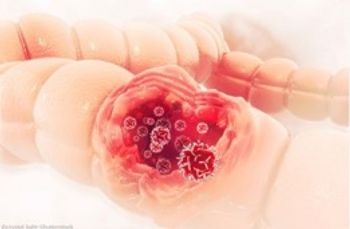
- ONCOLOGY Vol 16 No 2
- Volume 16
- Issue 2
Radioimmunotherapy Improves Response in Chemotherapy-Refractory NHL
A new study published in the Journal of Clinical Oncology (19:3918-3928, 2001) reported that radioimmunotherapy with tositumomab/iodine-131 tositumomab (Bexxar), produced more durable complete or partial clinical responses in patients with low-grade and transformed low-grade non-Hodgkin’s lymphoma (NHL) than did their last round of chemotherapy. All patients in the study had chemotherapy-refractory NHL. Typically, response rates and durations of response in refractory patients decline with each successive therapy, but in this study, the tositumomab/iodine-131 tositumomab combination was shown to reverse the expected outcome.
A new study published in the Journal of ClinicalOncology (19:3918-3928, 2001) reported that radioimmunotherapy with tositumomab/iodine-131tositumomab (Bexxar), produced more durable complete or partial clinicalresponses in patients with low-grade and transformed low-grade non-Hodgkin’slymphoma (NHL) than did their last round of chemotherapy. All patients in thestudy had chemotherapy-refractory NHL. Typically, response rates and durationsof response in refractory patients decline with each successive therapy, but inthis study, the tositumomab/iodine-131 tositumomab combination was shown toreverse the expected outcome.
"Bexxar therapy has resulted in durable remissions in a low-grade NHLpopulation refractory to chemotherapy, and in those with transformed low-gradeNHLan aggressive form of lymphoma that is associated with a very poorprognosis," said Mark S. Kaminski, md, professor of internal medicine andcodirector of the leukemia/lymphoma bone marrow transplant program at theUniversity of Michigan Cancer Center. "The results of this studydemonstrate a measurable improvement over previous therapy and suggest areversal of the downward trend seen in relapsed and refractory patientsfollowing prior treatments."
Significantly Higher Response Rates
The study investigated the safety and efficacy of tositumomab/iodine-131tositumomab compared to the patient’s previous chemotherapy. Researchersobserved a partial or complete response to the investigational combination in65% of patients vs a 28% response rate to the patient’s last chemotherapyagent. Results for patients achieving a complete response were 20% aftertositumomab/iodine-131 tositumomab compared to 3% after treatment with theirprevious drug. For patients who achieved a complete response with tositumomab/iodine-131tositumomab, the median duration of response has not yet been reached, and 9 ofthe 12 patients with complete responses have ongoing responses ranging from 32.3to 47.4 months.
"Bexxar demonstrated a high rate of response and a low rate ofhematologic toxicity in a heavily treated patient population," said Dr.Kaminski.
Tositumomab/iodine-131 tositumomab combines the targeting ability of amonoclonal antibody and the therapeutic potential of radiation, withpatient-specific dosing. The radiolabeled monoclonal antibody attaches to thetarget marker CD20 found on NHL cells, thereby eliciting an immune response anddelivering a dose of iodine-131 radiation to tumor cells.
"This targeted approach was designed to ensure that the tumor cells willreceive a greater concentration of the therapeutic radiation than normaltissues, and the radioactive component is probably a major factor in the drug’santitumor effect," said Dr. Kaminski.
Most side effects reported in this study were transient and mild to moderate.In addition, infusions of tositumomab/iodine-131 tositumomab were welltolerated. The principal toxicity was hematologic, with 18% of patientsexperiencing a reversible grade 4 decrease in white blood cells.
Dosages Tailored to Each Patient’s Needs
The study enrolled 60 patients who had been treated with at least two(median: 4) previous chemotherapy regimens and had not responded or hadprogressed within 6 months after treatment. This study was conducted in theUnited States and the United Kingdom.
Tositumomab/iodine-131 tositumomab was administered over two sessions,usually spaced 1 week apart. In the first session, patients received a 60-minuteinfusion of nonradioactive tositumomab. Then a trace amount of the radiolabeledantibody was administered to determine the patient-specific body clearance ofthe radiation. This rate was used to determine the precise therapeutic doseappropriate for each patient. During the next session, patients received another60-minute infusion of nonradiolabeled tositumomab followed by a 20-minuteinfusion of a patient-specific dose of iodine-131 tositumomab.
Bexxar is currently under review by the US Food and Drug Administration,which has granted the drug "orphan" status.
Articles in this issue
almost 24 years ago
Surgeon General Links Obesity to Canceralmost 24 years ago
Medicare Delays New Outpatient Payment Systemalmost 24 years ago
New Report on Nation’s Progress Against Cancer Releasedalmost 24 years ago
Atlas of Breast Cancer, Second Editionalmost 24 years ago
Subcutaneous Amifostine May Be as Effective as Intravenous Administrationalmost 24 years ago
Newly Designated NCI Director Roundly Applauded by Cancer Communityalmost 24 years ago
Stress Accelerates AIDS Progression, Undermines the Effect of Therapyalmost 24 years ago
Association of Community Cancer Centers Launches New Public Policy Websitealmost 24 years ago
Ineffective Cancer Pain Management AnalyzedNewsletter
Stay up to date on recent advances in the multidisciplinary approach to cancer.































































































